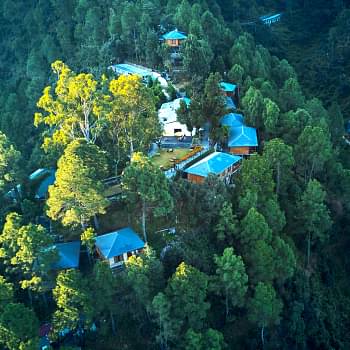February 04, 2020
Weekend Destinations in Corbett that you must explore

Revati Nargund


View all
140+
Resorts
February 04, 2020

Revati Nargund
Very few know that the legendary Jim Corbett was born in Nainital in 1875 and spent most of his life in present-day Uttarakhand, before he retired. Later he moved to Kenya soon after India’s Independence, where he passed away in 1955.
Corbett’s fascination with forests and wildlife began at a very early age, leading him to become a tracker and hunter. In time, he deployed his skills to tracking and killing man-eating tigers, and became a passionate defender of India’s natural heritage and its need to conserve its forests and wildlife. With his friend Frederick Champion, Corbett was instrumental in establishing the country’s first-ever national park, named after Lord Malcolm Hailey. It was renamed after Corbett two years after his death.
Spread over an area of 520 sq. km., Corbett National Park is among the few tiger reserves in India where you can stay within the park’s boundaries. Safaris and wildlife spotting can be done either in an open-topped four-wheeler or on elephants, making it one of the most sought-after destinations for wildlife enthusiasts worldwide.
But that’s not all. Within the park, or in close proximity to it, there are a number of places you can visit after you’re done tiger-spotting.
Situated at the edge of the Patli Dun valley, from where the Ramganga swells in size with numerous channels joining the main river, Dhikala is famous for its forest lodge, the only one in a National Park where you can stay overnight, literally in the midst of nature. From the watchtower, you can get an outstanding view of the valley, the Ramganga river, and the Kanda ridge.
Garjiya Devi temple is perched atop a huge rock in the Kosi River. Dedicated to Goddess Parvati, it is also home to the divinities of Lord Shiva, Lord Ganesha, Goddess Saraswati, and Baba Bhairon. The temple attracts thousands of devotees, especially during the fair held every year during Karthik Poornima. It is said that newly married couples visiting Corbett must seek the blessings of Garjiya Devi during their visit.
Sitabani lies adjacent to (but isn’t part of) Corbett. A haven for bird watchers, it’s the only forest where visitors are permitted to walk unimpeded. Known for its temple, river, and a jungle ashram, this historic place has an association with the Ramayana. It is said that Sitabani is the place where Sita spent her days in exile during her agnipariksha. It’s also believed that the earth at the ancient Valmiki temple located within the forest absorbed Sita into its fold.
This 66-foot waterfall is a sight to behold, especially on full moon nights. To reach it, visitors have to trek for over a mile through teak forests, before they emerge to a vision of water cascading through thick foliage into a lagoon-like pool. The water then flows over rocks and under a fallen tree trunk that spans the breadth of the stream. A swim in these cold, refreshing waters is a popular activity for day picnickers, while others can set up camp for the night at a designated location near the falls.
The Kosi river forms a large part of the eastern boundary of the Park, so you can be sure that the wildlife from Corbett will come to the river to quench their thirst, or to cool off during the hot summer months. The river is home to the Mahseer fish, and if you like angling, the catchment area has many camps set up for this very purpose. Migratory birds abound, so the place is a haven for birders and photographers. If you’re looking for an adrenaline rush, river rafting in the Kosi is a wonderful way to indulge.
zone The area in and around Bijrani is drier and has more diverse flora than Dhikala. During a time when shikar was popular, the area was famous for game hunting. Today Bijrani is the most in-demand part of Corbett, and known for its exotic flora and dense population of fauna, primarily due to the open grasslands combined with dense forest.
Corbett museum at Kaladhungi is a heritage bungalow that belonged to Jim Corbett, and where he lived. It showcases his personal belongings, a collection of letters written by him (as well as by his friends and well-wishers), antiques, and rare photographs. If you want to get a first-hand idea of what it was like to live and hunt over a century ago, this is the place to visit.
Jim Corbett National Park is truly a jewel in the crown of India’s conservation efforts. And Jim Corbett truly was a jewel in the crown of India’s fledgling efforts at conservation. Born British, he lived and died an Indian, deeply empathetic to the plight of the poor who lived in and around what was called Corbett village. The Corbett National Park is a fitting tribute to a giant, and one whose memory can only be enhanced by our appreciation of his efforts and passion.
Mahindra Holidays & Resorts India Ltd. (MHRIL), a part of Leisure and Hospitality sector of the Mahindra Group, offers quality family holidays primarily through vacation ownership memberships and brings to the industry values such as reliability, trust and customer satisfaction. Started in 1996, the company's flagship brand ‘Club Mahindra’, today has over 300,000 members , who can holiday at 140+ resorts in India and abroad.
We use cookies to personalise content and to provide you with an improved user experience.By Continuing to browse this site you consent to the use of cookies.Please visit our cookie policy for further details.

Welcome to ClubMahindra.com In order to provide a personalised experience for you, we use cookies to enable some website functionality. Cookies help us see which articles most interest you; allow you to easily share articles on social media channels; permit us to deliver content personalised to your interests and locations; along with many other site benefits. For more information, please review our Cookie Policy
When you visit any website, it may store or retrieve information on your browser, mostly in the form of cookies. This information might be about you, your preferences or your device and is mostly used to make the site work as you expect it to. The information does not usually directly identify you, but it can give you a more personalized web experience. Because we respect your right to privacy, you can choose not to allow some types of cookies. Click on the different category headings to find out more and change our default settings. However, blocking some types of cookies may impact your experience of the site and the services we are able to offer.
Because we respect your right to privacy, you can choose not to allow some types of cookies and you have the right to withdraw your consent by send a mail to email id [email protected]
These cookies are essential in order to enable you to move around the site and use its features, such as accessing secure areas of the site. Without these cookies, services you have asked for cannot be provided.
These cookies allow us to employ data analytics so we can measure and improve the performance of our site and provide more relevant content to you. These cookies don't collect information that identifies a visitor down to an individual level that is available to us. These cookies are not passing personally identifiable information to any external third party other than in limited cases when we engage a service provider to act on our behalf but who is then unable to use the data for their own purposes.
Performance cookies are generally third-party cookies from vendors we work with or who work on our behalf that collect information about your visit and use of the Club Mahindra website, for instance which pages you visit the most often, and if you get error messages from web pages. These cookies don't collect information that identifies a visitor. All information these cookies collect is anonymous and is only used to improve your overall experience on how the website works. Third party vendors may have access to this data and may use it to improve their overall services and offerings.
Functionality cookies allow a site to remember choices you make (such as your user name, language or the region you are in) and provide more enhanced, personal features. These cookies cannot track your browsing activity on other websites. They don't gather any information about you that could be used for advertising or remembering where you've been on the Internet outside our site.
Third-party advertising and social media cookies are used to (1) deliver advertisements more relevant to you and your interests; (2) limit the number of times you see an advertisement; (3) help measure the effectiveness of the advertising campaign; and (4) understand people's behaviour after they view an advertisement. They are usually placed on behalf of advertising networks with the site operator's permission. They remember that you have visited a site and quite often they will be linked to site functionality provided by the other organization. This may impact the content and messages you see on other websites you visit. If you do not allow these cookies you may not be able to use or see certain these sharing tools content on our website.